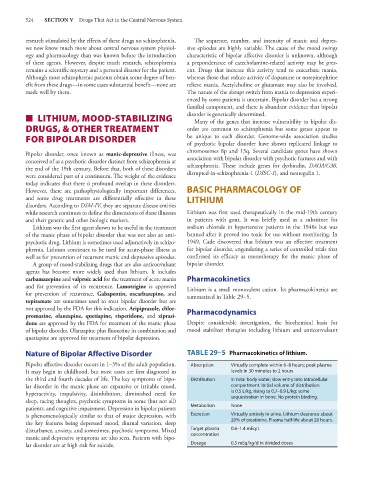Page 538 - Basic _ Clinical Pharmacology ( PDFDrive )
P. 538
524 SECTION V Drugs That Act in the Central Nervous System
research stimulated by the effects of these drugs on schizophrenia, The sequence, number, and intensity of manic and depres-
we now know much more about central nervous system physiol- sive episodes are highly variable. The cause of the mood swings
ogy and pharmacology than was known before the introduction characteristic of bipolar affective disorder is unknown, although
of these agents. However, despite much research, schizophrenia a preponderance of catecholamine-related activity may be pres-
remains a scientific mystery and a personal disaster for the patient. ent. Drugs that increase this activity tend to exacerbate mania,
Although most schizophrenic patients obtain some degree of ben- whereas those that reduce activity of dopamine or norepinephrine
efit from these drugs—in some cases substantial benefit—none are relieve mania. Acetylcholine or glutamate may also be involved.
made well by them. The nature of the abrupt switch from mania to depression experi-
enced by some patients is uncertain. Bipolar disorder has a strong
familial component, and there is abundant evidence that bipolar
■ LITHIUM, MOOD-STABILIZING disorder is genetically determined.
Many of the genes that increase vulnerability to bipolar dis-
DRUGS, & OTHER TREATMENT order are common to schizophrenia but some genes appear to
FOR BIPOLAR DISORDER be unique to each disorder. Genome-wide association studies
of psychotic bipolar disorder have shown replicated linkage to
chromosomes 8p and 13q. Several candidate genes have shown
Bipolar disorder, once known as manic-depressive illness, was
conceived of as a psychotic disorder distinct from schizophrenia at association with bipolar disorder with psychotic features and with
the end of the 19th century. Before that, both of these disorders schizophrenia. These include genes for dysbindin, DAOA/G30,
were considered part of a continuum. The weight of the evidence disrupted-in-schizophrenia-1 (DISC-1), and neuregulin 1.
today indicates that there is profound overlap in these disorders.
However, there are pathophysiologically important differences, BASIC PHARMACOLOGY OF
and some drug treatments are differentially effective in these LITHIUM
disorders. According to DSM-IV, they are separate disease entities
while research continues to define the dimensions of these illnesses Lithium was first used therapeutically in the mid-19th century
and their genetic and other biologic markers. in patients with gout. It was briefly used as a substitute for
Lithium was the first agent shown to be useful in the treatment sodium chloride in hypertensive patients in the 1940s but was
of the manic phase of bipolar disorder that was not also an anti- banned after it proved too toxic for use without monitoring. In
psychotic drug. Lithium is sometimes used adjunctively in schizo- 1949, Cade discovered that lithium was an effective treatment
phrenia. Lithium continues to be used for acute-phase illness as for bipolar disorder, engendering a series of controlled trials that
well as for prevention of recurrent manic and depressive episodes. confirmed its efficacy as monotherapy for the manic phase of
A group of mood-stabilizing drugs that are also anticonvulsant bipolar disorder.
agents has become more widely used than lithium. It includes
carbamazepine and valproic acid for the treatment of acute mania Pharmacokinetics
and for prevention of its recurrence. Lamotrigine is approved Lithium is a small monovalent cation. Its pharmacokinetics are
for prevention of recurrence. Gabapentin, oxcarbazepine, and summarized in Table 29–5.
topiramate are sometimes used to treat bipolar disorder but are
not approved by the FDA for this indication. Aripiprazole, chlor- Pharmacodynamics
promazine, olanzapine, quetiapine, risperidone, and ziprasi-
done are approved by the FDA for treatment of the manic phase Despite considerable investigation, the biochemical basis for
of bipolar disorder. Olanzapine plus fluoxetine in combination and mood stabilizer therapies including lithium and anticonvulsant
quetiapine are approved for treatment of bipolar depression.
Nature of Bipolar Affective Disorder TABLE 29–5 Pharmacokinetics of lithium.
Bipolar affective disorder occurs in 1–3% of the adult population. Absorption Virtually complete within 6–8 hours; peak plasma
It may begin in childhood, but most cases are first diagnosed in levels in 30 minutes to 2 hours
the third and fourth decades of life. The key symptoms of bipo- Distribution In total body water; slow entry into intracellular
lar disorder in the manic phase are expansive or irritable mood, compartment. Initial volume of distribution
hyperactivity, impulsivity, disinhibition, diminished need for is 0.5 L/kg, rising to 0.7–0.9 L/kg; some
sequestration in bone. No protein binding.
sleep, racing thoughts, psychotic symptoms in some (but not all)
patients, and cognitive impairment. Depression in bipolar patients Metabolism None
is phenomenologically similar to that of major depression, with Excretion Virtually entirely in urine. Lithium clearance about
the key features being depressed mood, diurnal variation, sleep 20% of creatinine. Plasma half-life about 20 hours.
disturbance, anxiety, and sometimes, psychotic symptoms. Mixed Target plasma 0.6–1.4 mEq/L
manic and depressive symptoms are also seen. Patients with bipo- concentration
lar disorder are at high risk for suicide. Dosage 0.5 mEq/kg/d in divided doses

